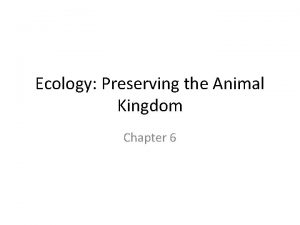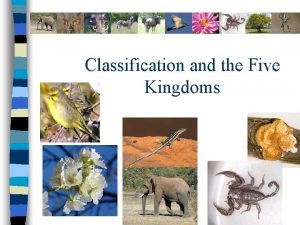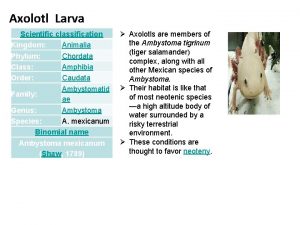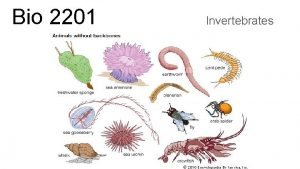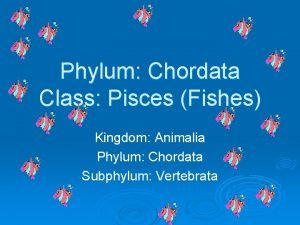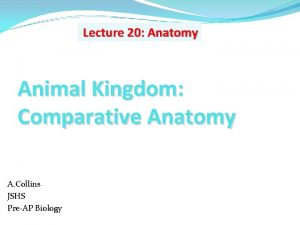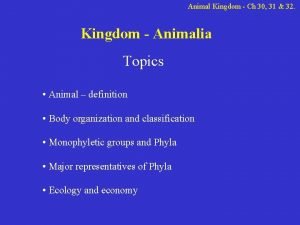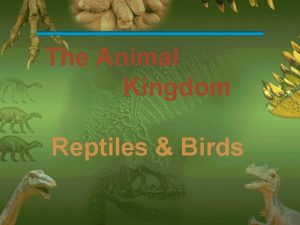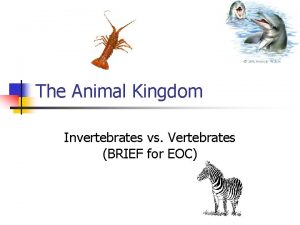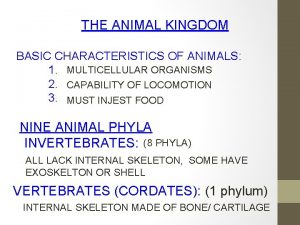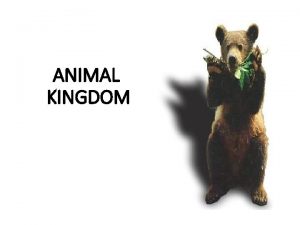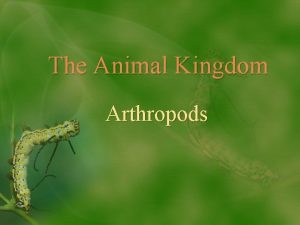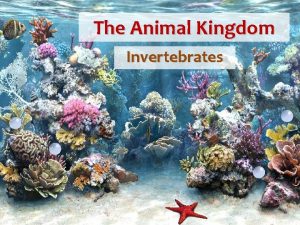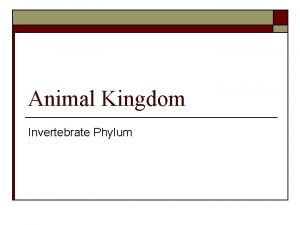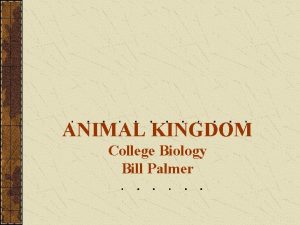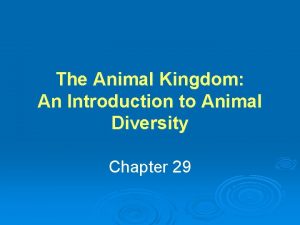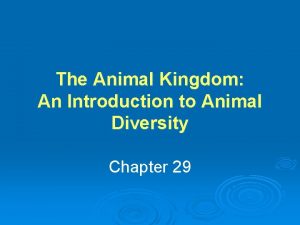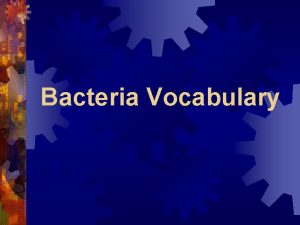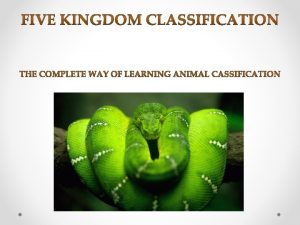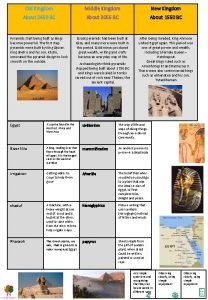The Animal Kingdom Introduction to the Animal Kingdom


























- Slides: 26

The Animal Kingdom

Introduction to the Animal Kingdom ©Holt D © 1994, Lavia © 2003 Tan & Yeo

Synapomorphies that define the major clades of the Animal Kingdom A- Development from a blastula B- Determinant development with well -developed tissue layers C- Radial symmetry D- Bilateral Symmetry E- Blastopore becomes mouth F- Blastopore becomes anus D

Synapomorphies that define the major clades of the Animal Kingdom What is a synapomorphy? synapomorphy Organisms share derived (apomorphic) character states… Provides evidence of evolutionary relationships between taxa D

Synapomorphies that define the major clades of the Animal Kingdom TRACE CHARACTER… A- Development from a blastula D

Synapomorphies that define the major clades of the Animal Kingdom TRACE CHARACTER… B- Determinant development with well -developed tissue layers D

Synapomorphies that define the major clades of the Animal Kingdom TRACE CHARACTER… C- Radial symmetry D- Bilateral Symmetry D

General Animal Life Cycle



Grades of Animal Groups • Cell Grade • Choanozoa • Tissue Grade • Parazoa • Organ Grade • Radiata • Bilateria

THE ANIMAL KINGDOM 1. The Animal Clade 2. The Unicellular Animals 3. The Multicellular Animals 4. The Tissue-Level Grade 5. The Organ-Level Grade 6. The Radiate Animals 7. The Bilaterians 8. The Nephrozoans 9. The Deuterostomes 10. The Protostomes 11. The Ecdysozoans 12. The Spiralians


Choanozoa CHOANOFLAGELLATES Single-celled, colonial, eukaryotes

Parazoa

Radiata

The Bilateria • Protostomata – Most animals • Deuterostomata – Only a few taxa, including the Craniates and Echinoderms

Examples of Protostomes • Nematoda

Examples of Protostomes • Arthropoda

Examples of Protostomes • Mollusca

Examples of Protostomes • Platyhelminthes

Examples of Protostomes • Syndermata

Examples of Deuterostomes • Echinodermata

Major Events in the Evolution of the Animals Lemons and Mc. Ginnis. 2006. Genomic Evolution of Hox Gene Clusters. Science. 313 (5795): 1918 -1922

Major Events in the Evolution of the Animals • Origin of animals following the period of Snowball Earth • The Ediacaran Fauna

Major Events in the Evolution of the Animals • Cambrian Explosion • Rise in oxygen and ozone • Rise in calcium • Appearance of Hox genes • Eyes • Predator-prey arms race • Increase in size
 Old kingdom middle kingdom new kingdom
Old kingdom middle kingdom new kingdom Old kingdom middle kingdom new kingdom
Old kingdom middle kingdom new kingdom Roman empire
Roman empire Old kingdom middle kingdom new kingdom
Old kingdom middle kingdom new kingdom What enables motile animals to move around
What enables motile animals to move around Similarities between protists and fungi
Similarities between protists and fungi Share
Share Eukarya plantae
Eukarya plantae Odds and ends kingdom
Odds and ends kingdom Wolf classification
Wolf classification Small white bear
Small white bear Biology taxonomy tree
Biology taxonomy tree Phylum horse
Phylum horse Ecology preserving the animal kingdom
Ecology preserving the animal kingdom Animal pyramid kingdom
Animal pyramid kingdom Kingdom of axolotl
Kingdom of axolotl Animal kingdom cladogram
Animal kingdom cladogram 6 kingdoms cladogram
6 kingdoms cladogram Morgan animal kingdom
Morgan animal kingdom Animal kingdom groups
Animal kingdom groups Pisces chordata
Pisces chordata Animal kingdom
Animal kingdom Carl linnaeus animal kingdom
Carl linnaeus animal kingdom Animal kingdom
Animal kingdom Reptiles order
Reptiles order Animal kingdom vertebrates and invertebrates
Animal kingdom vertebrates and invertebrates Characteristics of animal kingdom
Characteristics of animal kingdom













